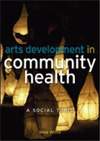Resources
As part of our advocacy for arts and health practice in primary care and community health, AHA plans to make available a wide range of resources, including articles, recommended texts and a directory of arts and health related material online.
Our resources section will expand over time, so please check back as more information becomes available.
Featured reading
Arts Development in Community Health
A Social Tonic
By Mike White
Research and Development Fellow in Arts in Health, Centre for Medical Humanities, Durham University and Senior Research Fellow, St Chad’s College, Durham.
Order online at shop.elsevier.com.au
 Arts in community health is a distinct area of activity that is characterised by the use of participatory arts to promote health.
Arts in community health is a distinct area of activity that is characterised by the use of participatory arts to promote health.
Based on the latest international research, this book considers how and why arts in community health has come about, the characteristics of its practice and the challenges it poses for evaluation.
The rapid growth of this field of work in the UK from the mid-1990s has begun to impact on policy in the arts funding system, on multi-sector partnerships for health service delivery, and in local authority cultural strategies, yet the reasons for its emergence and the nature and diversity of the practice itself have gone largely unaccounted for. It encompasses work in primary care, community health and public health.
Arts in community health has not evolved simply as a result of the successful advocacy of an arts sector keen to demonstrate its relevance to health, but rather through the wider recognition of a phenomenological connection between engagement in cultural activity and well-being. The pioneering viewpoints in this book promote an holistic approach to arts and public health, focusing on the development of the person and not just the sick or dysfunctional part of that person. Alongside the therapeutic benefits to patients, the book also considers environmental improvements to support staff, and using the arts to produce more creative kinds of health information.
This fully referenced guide compares and contrasts the arts in different cultures and healthcare systems, how well it works, why it works, and the factors that determine its success. The case studies examined prove shared creativity aids public health and simultaneously identifies and addresses the local and specific health needs in a community.

